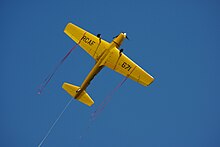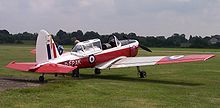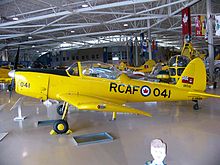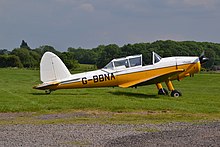de Havilland Canada DHC-1 Chipmunk
| DHC-1 Chipmunk | |
|---|---|

| |
| A Chipmunk with the Royal Navy historical flight | |
| Role | Trainer
|
| Manufacturer | de Havilland Canada |
| First flight | 22 May 1946 |
| Introduction | 1946 |
| Retired | 1955 (Belgium) 1972 (Canada) 1996 (United Kingdom) |
| Status | In service |
| Primary users | Royal Air Force (historical) Royal Canadian Air Force (historical) Portuguese Air Force |
| Produced | 1947–1956 |
| Number built | 1,284 (including Canadian, British, and Portuguese production)[1] |


The de Havilland Canada DHC-1 Chipmunk is a tandem, two-seat, single-engined primary
The Chipmunk was the first

The type was slowly phased out of service beginning in the late 1950s, although in the ab initio elementary training role, this did not happen in the Royal Air Force until 1996, when it was replaced by the Scottish Aviation Bulldog.
Many Chipmunks that had been in military use were sold to civilians, either to private owners or to companies, where they were typically used for a variety of purposes, often involving the type's excellent flying characteristics and its capability for aerobatic manoeuvres. More than 70 years after the type having first entered service, hundreds of Chipmunks remain airworthy and are in operation around the world.[1] The Portuguese Air Force still operates six Chipmunks, which serve with Esquadra 802, as of 2018.[2]
The aircraft is named after the chipmunk, a small rodent.
Development
Origins
Immediately following the conclusion of the


The Chipmunk prototype, CF-DIO-X, first flew on 22 May 1946 at Downsview, Toronto,[1] piloted by Pat Fillingham, a test pilot who had been seconded from the parent de Havilland company.[4] The prototype was powered by a 145 hp (108 kW) de Havilland Gipsy Major IC air-cooled inverted engine, this was replaced on the production version of the Chipmunk by a 145 hp (108 kW) de Havilland Gipsy Major 8 engine.
Production
de Havilland Canada constructed the type at its factory in
Both British-built and early Canadian-built Chipmunks are notably different from the later Canadian-built RCAF/Lebanese versions. The later Canadian-built aircraft were fitted with a bubble canopy, which replaced the multi-panelled sliding canopy that had been used upon early Canadian-produced Chipmunks, along with all of the Portuguese and British-built aircraft.[1] On the early-built canopy, the rearmost panels intentionally bulged in order to provide the instructor's position with superior visibility.[8] British-built Chipmunks also differed by a number of adjustments to suit the expressed preferences of the RAF. These included the repositioning of the undercarriage legs, anti-spin strakes, landing lights, and an all-round stressed airframe.[8]
At one point, work was being conducted on a derivative of the Chipmunk which featured an extensive cabin modification to accommodate a side-by-side seating arrangement; the aircraft, which was referred to as the DHC-2, ultimately remained unbuilt.[9] The DHC-2 designation was subsequently reallocated to the company's next product, the DHC-2 Beaver.[1]
Design
The de Havilland Canada DHC-1 Chipmunk is a two-seat, single-engine aircraft that has been heavily used as a primary trainer aircraft.
The structure of the Chipmunk makes heavy use of metal, the majority of the airframe being composed of a stress-skinned
In civilian service, individual aircraft would often be modified. Examples of these adaptations include extensive modifications that enabled it to perform competitive aerobatics, for which aircraft are often re-engined and fitted with constant speed propellers and inverted fuel systems; larger numbers of Chipmunks have been tasked as dedicated glider tows. It has become commonplace for Chipmunks to be re-engined, typically using the 180 hp (130 kW) Lycoming O-360.[1]
Operational history
United Kingdom
The
The fully aerobatic Chipmunk was ordered to serve as an ab initio trainer for new pilots.[citation needed] The RAF received 735 Chipmunks, which were designated in British service as the de Havilland Chipmunk T.10; these aircraft had been manufactured in the United Kingdom by de Havilland, the parent company of de Havilland Canada.
The Chipmunk T.10 initially served with Reserve Flying Squadrons (RFS) of the
From 1956 to 1990, the Chipmunks of the RAF Gatow Station Flight were used to conduct covert reconnaissance missions by BRIXMIS over the Berlin area.[11] A number of Chipmunk T.10s were also used by the Army Air Corps and Fleet Air Arm to conduct primary training. Notably, Prince Philip had his first flying lesson in a Chipmunk in 1952; he declared the type to be his favourite aircraft.[1]
Until 1996, Chipmunks remained in service with Air Training Corps (ATC) and the RAF Sections of the Combined Cadet Force (CCF) for Air Experience Flights (AEFs); the final of these AEF flights to use the Chipmunk was No. 10 Air Experience Flight, RAF Woodvale, when they were replaced by the Scottish Aviation Bulldog. The last Chipmunks in military service are still operated by the British historic flights – the RAF Battle of Britain Memorial Flight (including one of the Gatow aircraft), the Royal Navy and Army historic flights, to keep their pilots current on tailwheel aircraft. In addition, the cockpit sections of some former RAF Chipmunks have been used as ground training aids; these are colloquially known as "Chippax" trainers.[12][N 1]
In 1995 and 1996 the RAF planned for a pair of Chipmunks to circumnavigate the northern hemisphere to establish a route for light aircraft from Europe to North America via Russia. The RAF chose the Chipmunk because of its reliability and ability to operate with minimal ground support. Modifications were made before the journey, including expanding fuel capacity and updating navigation equipment. The Chipmunks were accompanied on the journey by a support aircraft. In 1996, the RAF started the journey, but had to stop in Moscow due to forest fires in central Siberia. The RAF successfully completed the journey in 1997, flying 16,259 miles over 64 days, visiting 62 airfields along the way. One of the two Chipmunks was added to the collection at the RAF Museum.[13] The other belongs to a private owner, who has restored the Chipmunk to its condition during the round-the-world flight and flies it to aviation events.[14]
Canada
In 1948 the RCAF accepted its first DHC-1 Chipmunk trainers, having received the first batch of a production run of 217 Chipmunks that would be manufactured in Canada.[15] The Chipmunk was the first Canadian-designed aircraft to be made abroad under licence and as such, the majority of the home-grown production were destined for the RCAF. However, Canadian-built Chipmunks were also delivered to some overseas customers, including Egypt, Lebanon and Thailand.[15]


Of the 113 Chipmunks that entered RCAF service, 79 were assigned to serve as ab initio trainers, while 34 were assigned to flying clubs for use in refresher training for RCAF Reserve pilots.[16] The type remained in use as a trainer until the early 1970s, the last example being retired from service by the Canadian Armed Forces in 1972, three years after unification of the Canadian Armed Forces.[15] The Chipmunk's long service was due, in part, to its fully aerobatic capabilities and superb flying characteristics, which had contributed towards pilots frequently referring to it as being "a delight to fly".[N 2]
On 2 June 2015, with the landing of his Chipmunk at
Portugal
The Portuguese Air Force (FAP) received its first DHC-1 Chipmunk Mk. 20 in 1951, being delivered to the Military Aeronautical School in Sintra. It was the first of an eventual 76 that would be delivered, replacing its almost two decade old de Havilland Tiger Moths. Its first 10 were constructed in the United Kingdom while the following 66 were licence-built by OGMA in Portugal. The Chipmunks would fly with the Elementary Flying Training Squadron (Esquadra de Instrução Elementar de Pilotagem).[2]
By 1986 only 36 Chipmunks still remained in service, flying with Esquadra de Instrução 101. With the Chipmunks being a 40-year-old design and with the annual attrition rate of the fleet being two aircraft, in October 1987 a decision was made by the FAP to replace the Chipmunks with 18 Aérospatiale TB 30 Epsilons. Epsilon deliveries was made throughout 1989, with all remaining Chipmunks being withdrawn from service by the time the last Epsilon was delivered. Shortly afterwards 7 Chipmunks were handed over to the Air Force Academy (AFA) to be used for glider towing.[2]
In 1997 a major reform was made to the FAP's training syllabus which led to the need for cost savings. This resulted in the 7 AFA Chipmunks being used by the FAP for an initial screen testing programme for potential pilots – the Estágio de Seleção de Voo (ESV). The 7 Chipmunks (serials – 1306, 1312, 1315, 1316, 1319, 1335, 1339) were first upgraded before being put into use. These upgrades consisted of replacing the Gipsy Major engines with the more powerful Lycoming O-360, adding a metal propeller, a new radio and an IFF transponder. Five of these aircraft were upgraded by OGMA at Alverca do Ribatejo, while the other two were converted by Indústrias Aeronáuticas de Coimbra (IAC). The first two upgraded Chipmunks were delivered to Esquadra 802 in July 1997 and began their screening programme the next month on 18 August. On 17 March 1998 an upgraded Chipmunk (serial – 1312) crashed on take-off at Sintra causing it to be written off, neither of the occupants – an Angolan student and Portuguese instructor – were harmed.[2][21] As of 2018, Esquadra 802 still operates the remaining 6 Chipmunks.[2]
Others
From the 1950s, the Chipmunk also became a popular civilian aircraft, having been used for various roles, such as pilot training, aerobatics and crop spraying. The majority of civilian aircraft are ex-military that had been resold and frequently modernised. It is also a mechanically sound aircraft and, consequently, many ex-RCAF Chipmunks have since remained operational for decades with private owners and operators around the world.[17] By 2001, several hundred Chipmunks were reportedly operational in private service.[8]
Variants
Canadian-built
- DHC-1A-1 (Chipmunk T.1)
- Powered by de Havilland Gipsy Major 1C engine, only partially aerobatic.[1]
- DHC-1A-2
- Powered by de Havilland Gipsy Major 10 engine, only partially aerobatic.[1]
- DHC-1B-1
- Powered by de Havilland Gipsy Major 1C engine, fully aerobatic.[1]
- DHC-1B-2
- Powered by de Havilland Gipsy Major 10 engine, fully aerobatic.[1]
- DHC-1B-2-S1
- Powered by de Havilland Gipsy Major 10 for Royal Egyptian Air Force.[1]
- DHC-1B-2-S2
- Powered by de Havilland Gipsy Major 10 for Royal Thai Air Force.[1]
- DHC-1B-2-S3 (Chipmunk T.2)
- Powered by de Havilland Gipsy Major 10 for RCAF refresher training operated by Royal Canadian Flying Clubs.[1]
- DHC-1B-2-S4
- Version for Chile.[1]
- DHC-1B-2-S5 (Chipmunk T.2)
- Additional units built for Royal Canadian Air Force.[1]
British-built

- Chipmunk T.10 (Mk 10)
- de Havilland Gipsy Major 8 engined version for the Royal Air Force, 735 built.[1]
- Chipmunk Mk 20
- Military export version of T.10 powered by de Havilland Gipsy Major 10 Series 2 engine, 217 built.[1]
- Chipmunk Mk 21
- Civil version of Mk 20 but fitted to civil standards, 28 built.[1]
- Chipmunk Mk 22
- T.10 converted for civilian use.[1] Conversion also involves restamping the Gipsy Major 8 (which is military) to a model 10-2 (which is civil).[citation needed]
- Chipmunk Mk 22A
- Mk 22 with fuel tankage increased to 12 Imperial gallons per side.[1]
- Chipmunk Mk 23
- Five converted T.10s powered by de Havilland Gipsy Major 10 Series 2 engine and with agricultural spray equipment.[6]
Portuguese-built
- Chipmunk Mk 20
- Military version powered by de Havilland Gipsy Major 10 Series 2 (145 hp) engine, 10 built in UK followed by 66 built by OGMA.[7][1] From 1989 onward, seven aircraft where updated and modified at OGMA (5) and Indústrias Aeronáuticas de Coimbra (2) to be used by the 802 Sqn. "Águias" (Eagles) – Air Force Academy squadron. The main modification was the installation of a more powerful 180 hp Lycoming O-360 engine. Their main tasks are related to supporting the Air Force cadets' aerial activities, mainly initial aptitude screening, glider tow and initial flight proficiency.
Civil conversions
- Masefield Variant
Modifications or conversions by Bristol Aircraft Ltd into a touring aircraft to design by Peter Masefield. Modifications could be made on Chipmunk Mk 20, Mk 21, Mk 22 and 22A aircraft. The Chipmunks could be fitted with luggage compartments in the wings, a blown canopy, landing gear fairings and enlarged fuel tanks.[22]

- Super Chipmunk
- Single-seat aerobatic aircraft, powered by a 194 kW (260 hp) Avco Lycoming GO-435 piston engine, equipped with revised flying surfaces and retractable landing gear; four conversions.[23]
- Turbo Chipmunk
In 1967–1968 a Chipmunk Mk 22A was converted, tested and flown by Hants and Sussex Aviation. The Chipmunk was fitted with an 86.42-kW (116-shp) Rover 90 turboprop engine.[24] and extra fuel capacity.
- Aerostructures Sundowner
- One Australian Chipmunk was fitted with a 180 hp (134 kW) Lycoming O-360 flat-four piston engine, wingtip tanks, clear-view canopy and metal wing skinning as the Sundowner touring aircraft.[25]
- Sasin Spraymaster
- Three Australian Chipmunks were converted into single-seat agricultural spraying aircraft.[25]

- Supermunk
- A prototype glider-tug designed and produced by officials of the glider tugs.[27][clarification needed]


- Scholl Super Chipmunk
- A number of Chipmunks were modified as aerobatic aircraft in the United States as the "Super Chipmunk". Along with an uprated engine, the aircraft underwent an extensive makeover including clipping its wings, adding retractable landing gear, conversion to a single-seat layout, adding an autopilot and being fitted with a red, white and blue wingtip and tail smoke system. The control stick was lengthened by three inches (76 mm) for greater control during extreme aerobatic manoeuvres. For over 25 years a Super Chipmunk in distinctive bright colour scheme of blue stars and sunburst effect was displayed by the aerobatic pilot EAA AirVenture Museum at Oshkosh, Wisconsin, USA.[28]
Operators
Civilian operators
Today, the Chipmunk remains popular with specialized flying clubs and is also operated by private individuals located in many countries worldwide.
Military operators
- Belgian Air Force In 1948, the Belgian Air Force acquired two DHC-1s for evaluation as a possible replacement for their de Havilland Tiger Moth trainers. In the end, they chose the Stampe-Vertongen SV.4 instead and the two Chipmunks were sold off to the civilian market in 1955.[29][30](retired)
- Burma Air Force(retired)
- Royal Canadian Air Force (retired)
- Ceylon
- Royal Ceylon Air Force(retired)
- Royal Danish Air Force (retired)
- Egyptian Air Force (retired)
- Ghana Air Force (retired)
- Irish Air Corps (retired)
- Iraqi Air Force (retired)[31]
- Israeli Air Force – One aircraft only. (retired)
- Royal Jordanian Air Force (retired)
- Kenya Air Force (retired)
- Lebanese Air Force (retired)
- Royal Malaysian Air Force (retired)
- Portuguese Air Force (six in use)
- Squadron 802, Águias (Sintra)
- Air Force Academy (Academia de Força Aérea, Sintra)
- Royal Saudi Air Force - 12 Chipmunk T.10s received in 1955.[32] (retired)
- Spanish Air Force– One aircraft only. (retired)
- Syrian Air Force (retired)
- Rhodesian Air Training Group4 Flying Training School. One aircraft WG354 preserved by the South African Air Force Museum. (retired)
- Royal Thai Air Force, developed as RTAF-4. (retired)

- British Army – Army Air Corps (retired)
- Basic Fixed Wing Flight
- Army Air Corps Historic Aircraft Flight
- Royal Air Force (retired, in use with Battle of Britain Memorial Flight)
- RAFVR RFS
- No.8 Sqn
- No.31 Sqn
- No.114 Sqn
- No.275 Sqn
- No.613 Sqn[33]
- No.663 Sqn[34]
- RAF Gatow (Berlin) Station Flight
- University Air Squadrons
- Air Experience Flights (Air Training Corps)
- Battle of Britain Memorial Flight
- Royal Navy – Fleet Air Arm (retired, in use with Royal Navy Historic Flight)
- Uruguayan Air Force (retired)
- Zambian Air Force (retired)
Specifications (DHC-1 Chipmunk)


Data from The de Havilland Canada Story and BAE Systems.[35][1]
General characteristics
- Crew: 2
- Length: 25 ft 5 in (7.75 m)
- Wingspan: 34 ft 4 in (10.46 m)
- Height: 7 ft 1 in (2.16 m)
- Wing area: 172 sq ft (16.0 m2)
- Airfoil: root: NACA 1415; tip: USA 35B[36]
- Empty weight: 1,517 lb (688 kg)
- Gross weight: 2,014 lb (914 kg)
- Max takeoff weight: 2,200 lb (998 kg)
- Powerplant: 1 × de Havilland Gipsy Major 1C4-cylinder air-cooled inverted in-line piston engine, 145 hp (108 kW)
- Propellers: 2-bladed fixed-pitch propeller
Performance
- Maximum speed: 138 mph (222 km/h, 120 kn) at sea level
- Cruise speed: 103 mph (166 km/h, 90 kn)
- Range: 259 mi (417 km, 225 nmi)
- Service ceiling: 15,800 ft (4,800 m)
- Rate of climb: 900 ft/min (4.6 m/s)
- Wing loading: 11.71 lb/sq ft (57.2 kg/m2)
- Power/mass: .072 hp/lb (0.118 kW/kg)
See also
Aircraft of comparable role, configuration, and era
- Fairchild PT-19
- Fokker S.11
- HAL HT-2
- LWD Junak
- Miles Magister
- Percival Prentice
- Yakovlev UT-2
- Zlín Z 26
Related lists
References
Notes
- ^ "Chippax" is an amalgamation of "Chipmunk" and "Pax" (an industry abbreviation for "passenger")
- ^ The Chipmunk's flight characteristics have been favourably compared to that of the wartime Supermarine Spitfire.[17][18]
Citations
- ^ a b c d e f g h i j k l m n o p q r s t u v w x y z aa ab ac ad ae "De Havilland Canada DHC-1 Chipmunk." BAE Systems, Retrieved: 22 April 2017.
- ^ a b c d e Degraef, Stefan; Borremans, Edwin (December 2018). "Forever Young". Air Forces Monthly. Key Publishing Ltd. pp. 40–43.
- ^ a b c d e f "de Havilland DHC1 Chipmunk T.Mk.10." de Havilland Aircraft Museum, Retrieved: 22 April 2017.
- ^ Bain 1992, p. 141.
- ^ Shields et al. 2009, p. 211.
- ^ a b Jackson 1987, p. 534.
- ^ a b Niccoli 1998, p. 27.
- ^ a b c d e f Fredriksen 2001, p. 92.
- ^ "D.H. Chipmunk". Flight. 15 July 1946. p. 619. Archived from the original on 25 July 2014. Retrieved 18 July 2014.
- ^ FlyPast No. 282. February 2005, pp. 74–5.
- ^ Shields et al. 2009, p. 276.
- ^ "Chippax." Archived 9 November 2016 at the Wayback Machine Sywell Museum. Retrieved: 21 July 2011.
- ^ "INDIVIDUAL HISTORY: DE HAVILLAND CHIPMUNK T.Mk.10 WP962/9278M MUSEUM ACCESSION NUMBER X002-3448" (PDF). Royal Air Force Museum. Retrieved 17 June 2018.
- ^ Stamm, Amy (6 April 2018). "The British (Aircraft) Are Coming". National Air and Space Museum. Retrieved 17 June 2018.
- ^ a b c "de Havilland Canada DHC-1B2 Chipmunk 2." Archived 16 October 2013 at the Wayback Machine Canada Aviation and Space Museum. Retrieved: 26 July 2011.
- ^ "De Havilland Canada DHC-1 Chipmunk." Archived 26 August 2011 at the Wayback Machine Canadian Centennial of Flight, 2009. Retrieved: 26 July 2011.
- ^ a b "de Havilland Canada DHC-1 Chipmunk." Canadian Warplane Heritage Museum, Retrieved: 26 July 2011.
- ^ Shields, Hugh et al. 2009, pp. cover, back cover.
- ^ Anonymous, "World's Oldest pilot." Aviation History, November 2015, p. 10.
- ^ Lynch, Kerry. "George Neal Enters Guinness Record Book as Oldest Pilot." AIN Online, 22 June 2015.
- ^ "Accident de Havilland Canada DHC-1-200 Chipmunk 1312, 17 Mar 1998". Aviation Safety Network. Retrieved 20 November 2018.
- ^ "Masefield Chipmunk". Flight. 15 July 1960. p. 105. Archived from the original on 29 September 2009.
- ^ a b "De Havilland-Canada DHC-1A Chipmunk, Pennzoil Special." Smithsonian, Air and Space Museum, 2005. Retrieved: 6 February 2009.
- ^ Jackson 1987, p. 535.
- ^ a b Eyre 1983, p. 189.
- ISBN 978-0-7106-0748-5.
- ^ WEBTEAM, FAP-. "Força Aérea Portuguesa". www.emfa.pt (in European Portuguese). Retrieved 28 March 2020.
- ^ "de Havilland DHC-1B-2 Chipmunk – N1114V." AirVenture Museum. Retrieved: 6 February 2009.
- ^ "De Havilland Canada DHC.1A Chipmunk". Belgian Wings. Archived from the original on 4 April 2016. Retrieved 20 November 2018.
- ^ "De Havilland Canada DHC.1A Chipmunk". Belgian Military Aircraft Database. Archived from the original on 20 November 2018. Retrieved 20 November 2018.
- ISBN 978-1-913118-74-7.
- ^ Cooper 2017, p. 14
- ^ Halley 2003, p. 21.
- ^ Halley 2003, p. 76.
- ^ Hotson 1983, p. 237.
- ^ Lednicer, David. "The Incomplete Guide to Airfoil Usage". m-selig.ae.illinois.edu. Retrieved 16 April 2019.
Bibliography
- Bain, Gordon. de Havilland: A Pictorial Tribute. London: AirLife, 1992. ISBN 1-85648-243-X.
- Cooper, Tom (2017). Hot Skies Over Yemen, Volume 1: Aerial Warfare Over the South Arabian Peninsula, 1962-1994. Solihull, UK: Helion & Company Publishing. ISBN 978-1-912174-23-2.
- Eyre, David. "Sasin/Aerostructures SA29 Spraymaster." The Illustrated Encyclopedia of Aircraft in Australia and New Zealand. Hornsby NSW: Sunshine Books, 1983. ISBN 0-86777-272-7.
- Fisher, Bill. Chipmunk: The First Forty Years. Berkhamsted, Hertfordshire, UK: de Havilland Type Design Organisation, 1986.
- Fisher, Bill. Chipmunk: The First Fifty Years. Berkhamsted, Hertfordshire, UK: de Havilland Type Design Organisation, 1996.
- Fredriksen, John C. International Warbirds: An Illustrated Guide to World Military Aircraft, 1914–2000. ABC-CLIO, 2001. ISBN 1-57607-364-5.
- Halley, J.J. Royal Air Force Aircraft WA100 to WZ999. Tonbridge, Kent, UK: Air-Britain (Historians) Ltd., 2003. ISBN 0-85130-321-8.
- Hotson, Fred. The de Havilland Canada Story. Toronto: CANAV Books, 1983. ISBN 0-9690703-2-2.
- The Illustrated Encyclopedia of Aircraft (Part Work 1982–1985). London: Orbis Publishing.
- Jackson, A.J. British Civil Aircraft since 1919 Volume 2. London: Putnam, 1974. ISBN 0-370-10010-7.
- Jackson, A.J. De Havilland Aircraft since 1909. London, Putnam. Third edition, 1987. ISBN 0-85177-802-X.
- Niccoli, dott Riccardo. "Atlantic Sentinels: The Portuguese Air Force since 1912". Air Enthusiast, No. 73, January/February 1998. pp. 20–35. Stanford, UK: Key Publishing. ISSN 0143-5450.
- Shields, Hugh et al. The de Havilland Canada DHC-1 Chipmunk: The Poor Man's Spitfire. St. Thomas, Ontario: SBGB Publishing, 2009. ISBN 978-0-9812544-0-1.
External links
- RAF Museum
- National Air Force Museum of Canada
- "The D.H. Chipmunk" a 1947 Flight article
- "The Turbine Chipmunk" a 1967 Flight article on the Rover TP.90 experiments
- "In Vogue Again: The de Havilland Chipmunk" a 1974 Flight article
- Article on the RAF BBMF (Battle of Britain Memorial Flight)
